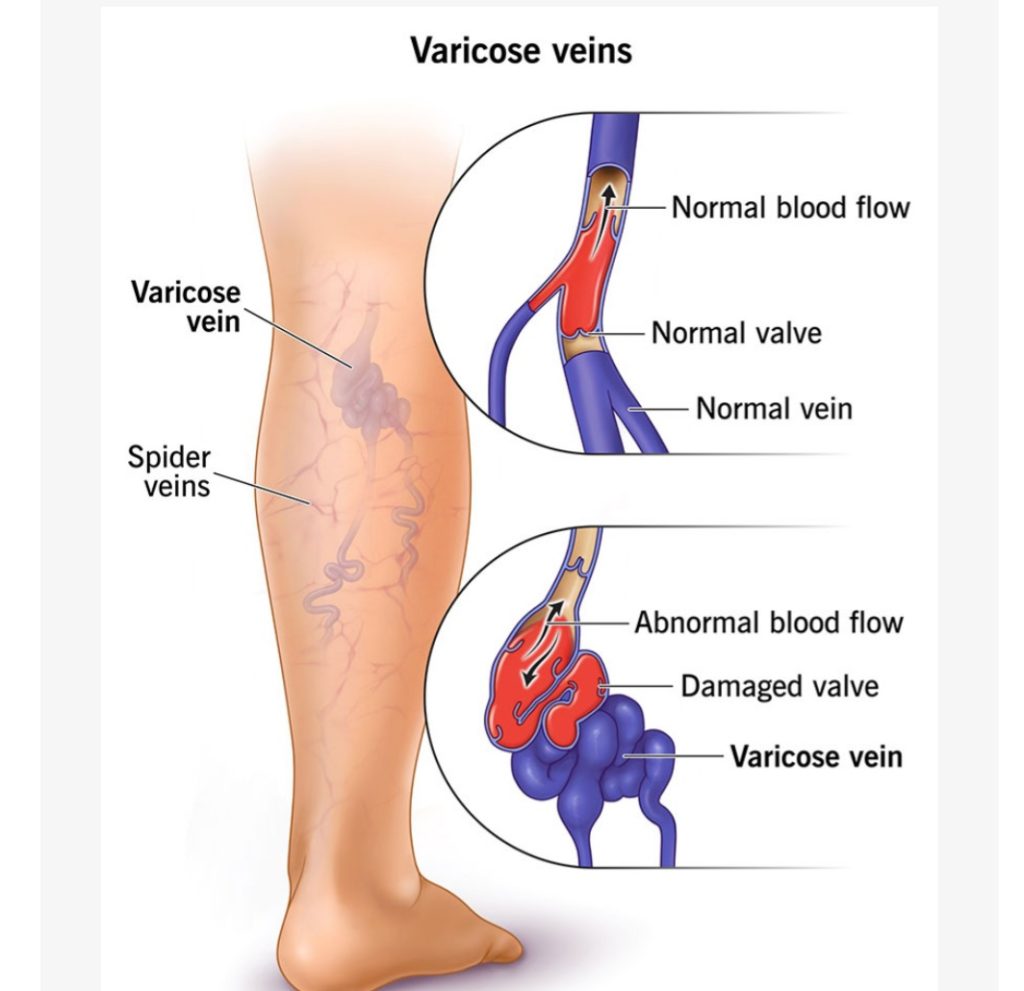Varicose veins – those swollen, twisted veins often visible on the legs – are more than a cosmetic issue. They signal an underlying imbalance in your body’s circulation system. While modern medicine addresses the physical structure of veins, Ayurveda offers a profound, root-cause approach. Known as “Siraja Granthi” in classical texts, Ayurveda links varicose veins primarily to an aggravated Vata dosha (especially Vyana Vayu, governing circulation) and impurities in the blood tissue (Rakta dhatu), often stemming from poor digestion (Ama). So here is the complete Ayurvedic Varicose Veins treatment.

Why Do Varicose Veins Form? The Ayurvedic View
Think of your circulatory system like a network of rivers. When:
- Vata gets disturbed (Especially Vyana Vayu) – This disrupts smooth blood flow, causing stagnation and increased pressure on vein walls. Factors include chronic stress, erratic routines, excessive exercise, and cold exposure.
- Blood becomes impure (Rakta dhatu vitiation) – Toxins (Ama) from poor digestion, unhealthy foods, or pollutants make blood thick and sluggish, leading to inflammation and congestion.
- Digestion weakens (Mandagni) – Weak digestive fire creates Ama, which clogs micro-channels (srotas), including those carrying blood.
The result? Veins weaken, bulge, and become painful – Siraja Granthi manifests.
Core Ayurvedic Strategies: Internal Herbal Support
Ayurvedic treatment focuses on calming Vata, purifying blood, reducing inflammation, strengthening veins, and clearing Ama. Key herbs and formulations include:
- Manjistha (Rubia cordifolia): The premier blood purifier (Raktashodhaka). Reduces congestion, inflammation, and improves microcirculation. Often taken as powder (churna) or tablets. Research suggests active compounds support its detoxifying effects.
- Guggulu (Commiphora mukul) Formulations: Potent resin-based combinations:
- Kaishore Guggulu: Most specific for varicose veins. Combines Guggulu with Triphala (detox), Guduchi (immunity), Ginger (circulation). Targets pain, inflammation, and blood purification.
- Punarnavadi Guggulu: Best for significant swelling (Shotha), thanks to Punarnava’s diuretic action.
- Yogaraja Guggulu: Ideal for severe Vata pain, stiffness, and muscle cramps.
- Gotu Kola (Centella asiatica): A vein superstar. Clinically shown to boost collagen, strengthen vein walls, improve blood flow, and reduce edema. Taken as powder, capsules, or juice. Studies highlight its vascular benefits.
- Triphala (Amalaki, Bibhitaki, Haritaki): The gentle digestive cleanser. Reduces Ama formation, supports gentle detox, improves circulation, and prevents constipation (crucial, as straining worsens vein pressure).
- Sahacharadi Kashayam: A classical herbal decoction specifically for Vata disorders in the legs – addressing pain, numbness, heaviness, and venous weakness.
- Chandraprabha Vati: Useful when there’s associated coldness, heaviness (Kapha), or chronic tissue weakness. Reduces inflammation and supports tissue health.
Soothing Relief: External Therapies
Direct applications provide comfort and support healing:
- Sahacharadi Thailam: The primary medicated oil. Massage gently towards the heart (never vigorous rubbing upwards) to reduce pain, inflammation, and encourage circulation.
- Ksheerabala Thailam / Pinda Thailam: Excellent for dry or sensitive skin. Deeply nourishing and Vata-pacifying.
- Cooling Herbal Pastes (Lepam):
- Manjistha + Neem + Turmeric: Mix powders with rose water. Apply to reduce burning, inflammation, and skin discoloration.
- Fresh Gotu Kola Leaves: Crush and apply directly to leverage its vein-strengthening power topically.
The Essential Foundation: Diet & Lifestyle
Medicines work best when supported by daily habits:
- Diet (Aahar):
- Avoid: Heavy, processed, fried foods, excess salt/sugar, red meat, refined carbs (white bread/pasta), stale food, excess caffeine & alcohol. These fuel Ama and inflammation.
- Embrace: Light, warm, cooked meals. High fiber (oats, lentils, vegetables – leafy greens, beets, carrots, onion, garlic) to prevent constipation. Antioxidant-rich fruits (berries, citrus, pomegranate). Healthy fats (moderate ghee, olive oil). Warm water & anti-inflammatory teas (ginger, cinnamon).
- Smart Movement (Vyayam):
- Avoid: Heavy lifting, high-impact workouts, prolonged standing/sitting without breaks.
- Choose: Walking (activates the calf muscle pump – vital for venous return!). Swimming or Cycling (gentle on joints). Supportive Yoga: Viparita Karani (Legs-Up-the-Wall – excellent for drainage), Pawanmuktasana series (aids circulation), Tadasana (Mountain pose – improves posture). Avoid Sarvangasana (Shoulder Stand) without expert guidance, especially in severe cases.
Daily Habits: Elevate legs when resting/sleeping. Wear loose clothing (avoid tight waistbands). Maintain a healthy weight. Manage stress (aggravates Vata) via meditation or deep breathing.
Deep Cleaning: Panchakarma Therapy (Under Expert Guidance)
For chronic/severe cases, supervised Panchakarma detox can be transformative:
- Vasti (Medicated Enema): The primary treatment for deep-seated Vata imbalance. Uses herbal decoctions/oils administered rectally to improve circulation and remove toxins.
- Virechana (Therapeutic Purgation): Purifies the liver and blood (Rakta dhatu) by eliminating toxins through the bowels.
- Raktamokshana (Bloodletting): Highly specialized. Used rarely in chronic, stubborn cases with severe blood vitiation (e.g., via leeches). ONLY performed by experienced practitioners after thorough assessment.
Key Considerations & Realistic Expectations
- Consult an Ayurvedic Physician (Vaidya): This is essential. Do not self-prescribe. A Vaidya diagnoses your unique constitution (Prakriti), imbalance (Vikriti), and severity to tailor treatments and dosages. Herbs like Guggulu have contraindications (e.g., with blood thinners, pregnancy).
- Severity Matters: Ayurveda excels in early stages and symptom management (pain, swelling, heaviness). Large, bulging, ulcerated, or bleeding veins need modern medical evaluation (Doppler ultrasound). Procedures like laser ablation or sclerotherapy might be necessary. Ayurveda can still support recovery or complement conservative management.
- Patience & Consistency: Results build over weeks to months of consistent herbal use, diet, and lifestyle changes. This is a journey, not a quick fix.
- Watch for Red Flags: Seek immediate conventional medical care for: sudden severe pain/swelling (possible DVT), skin ulcers, bleeding veins, or significant skin hardening.
The Takeaway: Restoring Balance from Within
Ayurveda offers a powerful, holistic lens for varicose veins. By addressing the root causes – disturbed Vata, impure blood, and weak digestion – through targeted herbs, supportive therapies, and mindful living, it promotes lasting venous health and overall vitality. Partnering with a qualified Vaidya ensures a safe and personalized approach. Remember, your commitment to these principles is the true key to unlocking better circulation and healthier veins.